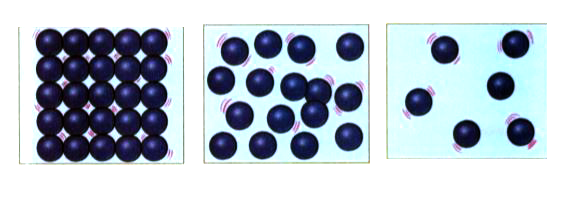(c) Under what conditions do solids, liquids and gases change their state ?
To answer the question about the conditions under which solids, liquids, and gases change their state, we can break it down into a step-by-step explanation.
1. Understanding States of Matter:
- Matter exists in three primary states: solid, liquid, and gas. Each state has distinct properties such as shape, volume, and particle arrangement.
2. Changing Temperature:
- One of the main conditions for changing the state of matter is temperature.
- Heating a Solid: When a solid is heated, its temperature increases, causing the particles to gain energy and move more freely. Eventually, this can lead to melting, where the solid turns into a liquid.
- Heating a Liquid: If the liquid continues to be heated, it can reach its boiling point, at which point it will change into a gas (vaporization).
3. Cooling a Gas or Liquid:
- Conversely, if you decrease the temperature of a gas, it can condense into a liquid. If you further decrease the temperature of the liquid, it can freeze into a solid.
4. Changing Pressure:
- The second condition for changing the state of matter is pressure.
- Increasing Pressure: When pressure is increased, it can cause gases to condense into liquids and liquids to solidify. This is because higher pressure forces the particles closer together.
- Decreasing Pressure: Reducing pressure can allow solids to melt into liquids and liquids to evaporate into gases.
5. Examples:
- A common example is ice (solid). When heated, it melts into water (liquid). If the water is heated further, it turns into steam (gas).
- Conversely, if steam is cooled, it condenses back into water, and if water is cooled further, it freezes into ice.
Summary
In summary, solids, liquids, and gases change their state primarily due to changes in temperature and pressure. Increasing temperature can lead to melting and vaporization, while decreasing temperature can lead to freezing and condensation. Similarly, changes in pressure can also facilitate these transitions.
---
- Matter exists in three primary states: solid, liquid, and gas. Each state has distinct properties such as shape, volume, and particle arrangement.
- One of the main conditions for changing the state of matter is temperature.
- Heating a Solid: When a solid is heated, its temperature increases, causing the particles to gain energy and move more freely. Eventually, this can lead to melting, where the solid turns into a liquid.
- Heating a Liquid: If the liquid continues to be heated, it can reach its boiling point, at which point it will change into a gas (vaporization).
- Conversely, if you decrease the temperature of a gas, it can condense into a liquid. If you further decrease the temperature of the liquid, it can freeze into a solid.
- The second condition for changing the state of matter is pressure.
- Increasing Pressure: When pressure is increased, it can cause gases to condense into liquids and liquids to solidify. This is because higher pressure forces the particles closer together.
- Decreasing Pressure: Reducing pressure can allow solids to melt into liquids and liquids to evaporate into gases.
- A common example is ice (solid). When heated, it melts into water (liquid). If the water is heated further, it turns into steam (gas).
- Conversely, if steam is cooled, it condenses back into water, and if water is cooled further, it freezes into ice.
In summary, solids, liquids, and gases change their state primarily due to changes in temperature and pressure. Increasing temperature can lead to melting and vaporization, while decreasing temperature can lead to freezing and condensation. Similarly, changes in pressure can also facilitate these transitions.
Topper's Solved these Questions
Similar Questions
Compare densities of solids, liquids, and gases.
View SolutionList the characteristics of solids, liquids and gases
View Solution(b) Why do solids, liquids and gases differ in their physical state ?
View SolutionOut of solids, liquids, and gases, which can be compressed the most?
View Solutionunder what conditions do ethers from oxonium salts?
View SolutionUnder what condition do non-ideal solutions show negative deviations?
View SolutionCan sound pass through solids, liquids, and gases? Give reason.
View SolutionOn cooling, liquid changes into a solid state.
View SolutionUnder what conditions do we use fractional distillation ?
View Solution
a.Identify which of the above pictures shows particle arrangement in solids, liquids and gases. Write in the space below each picture.
b. Which state of matter would you expect to show a fixed volume?
c. Why do you think gases can flow whereas solids cannot?
View Solution
